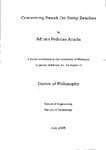Concerning Swash On Steep Beaches
| dc.contributor.author | Acuna, Adrian Pedrozo | |
| dc.contributor.other | Faculty of Science and Engineering | en_US |
| dc.date.accessioned | 2013-09-13T08:38:36Z | |
| dc.date.available | 2013-09-13T08:38:36Z | |
| dc.date.issued | 2005 | |
| dc.identifier | NOT AVAILABLE | en_US |
| dc.identifier.uri | http://hdl.handle.net/10026.1/1672 | |
| dc.description.abstract |
This investigation focuses on the prediction of sediment transport and beach evolution in coarse-grained beaches. This includes observed morphological changes on both gravel and mixed beaches from experimental investigations at the Large Wave Flume (GWK) in Hanover. Germany. The recorded measurements show that the majority of morphology change took place adjacent to the zone of wave-breaking, close to the shoreline in both cases. Based on these observations, the discussions are carried out with psirticular regard to the observed tendency for onshore transport axid profile steepening in the swash zone. The aim is to identify the cross-shore hydrodynamics and sediment transport mechanisms involved, to advance understanding of this type of beach and to improve our qucintitative capabilities for predicting shoreline and morphological changes in this zone. With this in mind, this thesis includes a discussion of the physical processes related to swash hydrodynamics and sediment transport. It also introduces the description of the mathematical framework used to study wave hydrodynamics in the swash zone. Emphasis is given to the Boussinesq equations which have been found to be a suitable approach. For these equations an evaluation of the two available shoreline boundary conditions is carried out and it is shown that the moving shoreline accurately reproduces the velocity field in the swash zone. The profile evolution investigation is carried out evaluating the transport rates from a bed-load sediment transport formulation coupled with velocities calculated from a set of Boussinesq equations [Lynett et al 2002). Then the equation for conservation of sediment is solved to estimate the morphological changes as proposed by (Rakha et al 1997). It is shown that such an approach is useful to investigate the processes that control this evolution. A discussion on the influence of bottom friction on the predicted profiles is presented. Numerical results in both beaches show that the use of a higher friction factor f during uprush improves the simulations of morphological changes. However, the variation of friction by itself was not able to reproduce the measured profiles. A plausible reason to explain this is that further mechanisms other than friction play an important role in the overall response of coarsegrained beaches. For both beaches it is established that, if the efficiency factor (C) in the sediment transport equation and bottom friction are kept the same in the uprush and backwash, accurate representation of profile evolution is not possible. Indeed, the features of the predicted profiles are reversed. When the C parsimeter is set larger during the uprush than during the backwash, the predicted profiles are closer to the observations. Differences between the predicted profiles from setting non-identical C-values and friction factors for the swash phase, are believed to be linked to both the infiltration effects on the flow above the beachface, the bore collapse picking up sediment from the bed, and the accelerated flow in the uprush. The discussion is made with reference to main physical processes acting over the beachface for both the mixed and gravel beach. | en_US |
| dc.language.iso | en | en_US |
| dc.publisher | University of Plymouth | en_US |
| dc.title | Concerning Swash On Steep Beaches | en_US |
| dc.type | Thesis | |
| plymouth.version | Full version | en_US |
| dc.identifier.doi | http://dx.doi.org/10.24382/4057 |
Files in this item
This item appears in the following Collection(s)
-
01 Research Theses Main Collection
Research Theses Main


